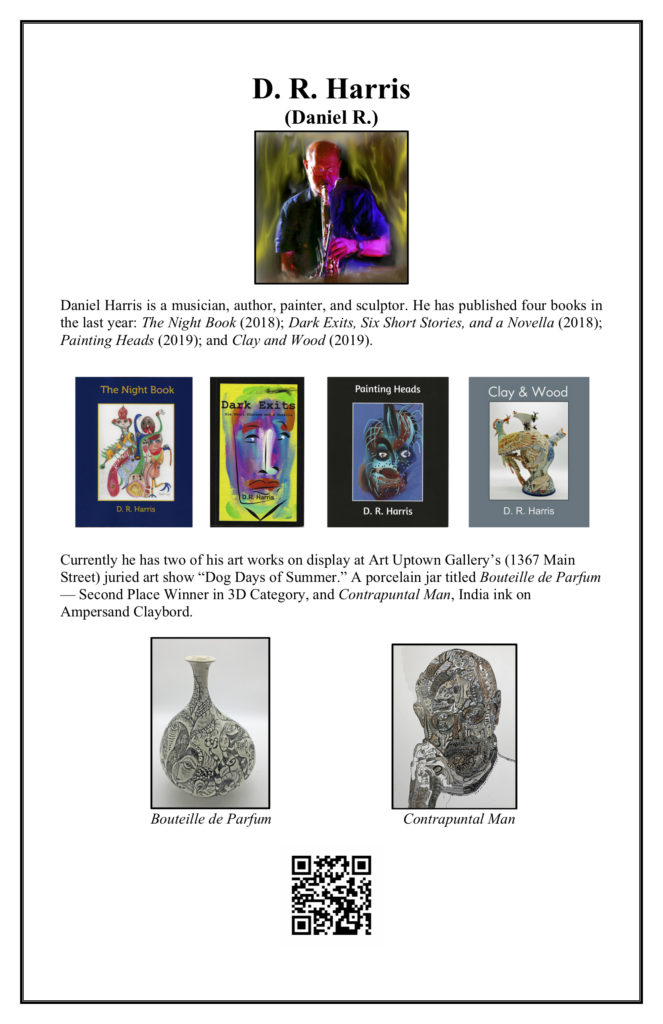July 21, 1948. Sherman, Connecticut
The lanky broken man walked with short quick steps on the uneven path. His long-fingered right hand held a length of cheap grocery store clothesline. He wore jeans, a black-and-white checked wool shirt and dress slip-on shoes without socks. His thinning black hair framed his pallid complexion. The whites of his eyes had a faint blue patina. A heavy leather-and-steel orthopedic brace encircled his neck. If he was in pain, it was not apparent from his facial expression, which seemed to relax into a beatific smile with each step. His legs, which initially felt heavy, shed weight as he switched his gait to a drag-leg hop-skip. In his native Turkish-Armenian, he repeated a three-word phrase until it became an unintelligible rhythmic singsong. A large mixed-breed dog and a dachshund followed the man. Ahead was a small three-sided shack situated beside a large stone crusher, remnants of a former resident’s mining ambitions. In the shack were stacks of empty wooden wine crates. The man entered the shack, took one of the wine crates and situated it under a roof joist. Standing on the wine crate, he tied the clothesline to the joist and made a slipknot at the lower end. He stepped off the crate and pulled a piece of white chalk from his pocket. On another wine crate he wrote Good-by all my loved. He wanted to write more, but the chalk broke. He tossed the pieces of chalk out the open side of the shack onto the grass. His mind was not his own. He was ready to escape the physical pain, misery, humiliation, career failure, ridicule and recent cuckoldry he had suffered. His life had become a lie. Even his American name was a lie. He had devoted his life to art, but art had walked out on him. He removed the leather and metal brace from his neck, dropping it on the earthen floor. He could smell the rising summer heat from the quarry. He stood on the crate, put the loop of clothesline around his neck, and without hesitation kicked the wine crate from under his feet. The clothesline stretched until his toes were an inch from the earth. His weakened neck made a sharp click sound. His last exhale caused his jeans to drop to his pubis revealing the bandages around his abdomen from his recent colon surgery. The dachshund began barking. The dead man was the acknowledged father of Abstract Expressionism: the painter Arshile Gorky.
July 21, 1948. Union Square, New York City
Unknown to the thief, the click of the lock on Gorky’s Union Square studio door in New York City coincided with the crack of Gorky’s neck in Sherman, Connecticut. The object he sought was the painting on the studio’s large easel. That painting, The Unfaithful Wife, depicted a nude woman lying on her back on an unmade bed, legs akimbo. She beckoned to the man who stood at one side of the bed. Her figure was foreshortened making her head appear smaller as it receded toward the headboard at the top of the picture frame while exaggerating the size of her legs and hips. The perspective made the naked man’s erection appear larger than normal; his eyes were glistening in anticipation of sexual pleasure. Both figures were painted with wild stabbing brush and palette knife strokes. The setting was a room filled with a pale rose and yellow fog, like blood in urine. Bodily details were intensified by impasto, a technique Gorky rarely used. There was enough detail to reveal, to those who knew the subjects and the painter, that the woman was Gorky’s wife Agnes Magruder and her lover the Chilean painter Roberto Matta. The painting was small for Gorky, 20 inches wide by 26 inches high; but with the neck brace and broken collarbone from a recent auto accident, it was as large a painting as he could manage. It was signed “a Gorky.” On the back was the date 19 July 1948. The title, The Unfaithful Wife, was crudely printed in cadmium red oil paint on the back of the painting along the upper stretcher bar.
The painting had been slashed with a knife from the upper left corner to the bottom right separating the woman from the man. The knife had been thrown into the wooden floor a foot from the easel with such force that the point was buried an inch deep. The thief, Roberto Matta, removed the painting from the easel; the paint had not dried and was tacky. He carefully wrapped it in white butcher paper. He locked the door of the studio and left with the painting. Gorky’s body had yet to be discovered in Connecticut. Matta began thinking about lunch with Agnes.
December 29, 1975. 12th Arrondissement, Paris
The man, a tall handsome Russian-American artist with jet black hair, full lips and soft dark eyes, sat at a table in a cozy non-descript bar near Gare de Lyon. The room consisted of a six-stool bar with three tables along the opposite mirrored wall. Ice from the freezing rain covered the small table outside on the sidewalk. Two prostitutes sat at the bar smoking and drinking wine. The sleet blanketed holiday decorations and rendered the Monday evening rush hour streets and sidewalks treacherous. From his position behind the bar, the bartender, a short stocky man with a Stalin mustache and thick blond hair, watched the sleet and rain blur the reflected automobile lights in the bar window.
Continue reading “Prologue Five Million Yen”